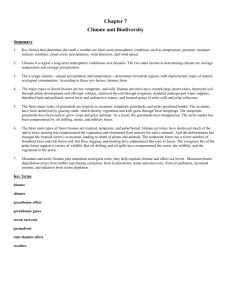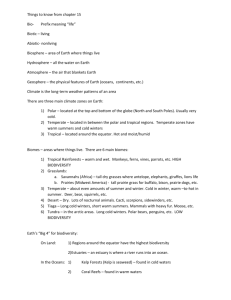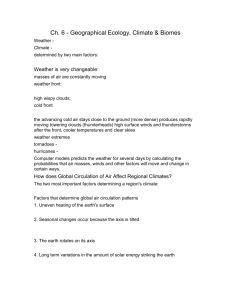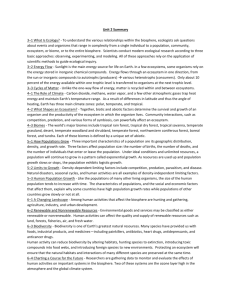CLIMATE, GEOGRAPHICAL ECOLOGY AND BIOMES
advertisement
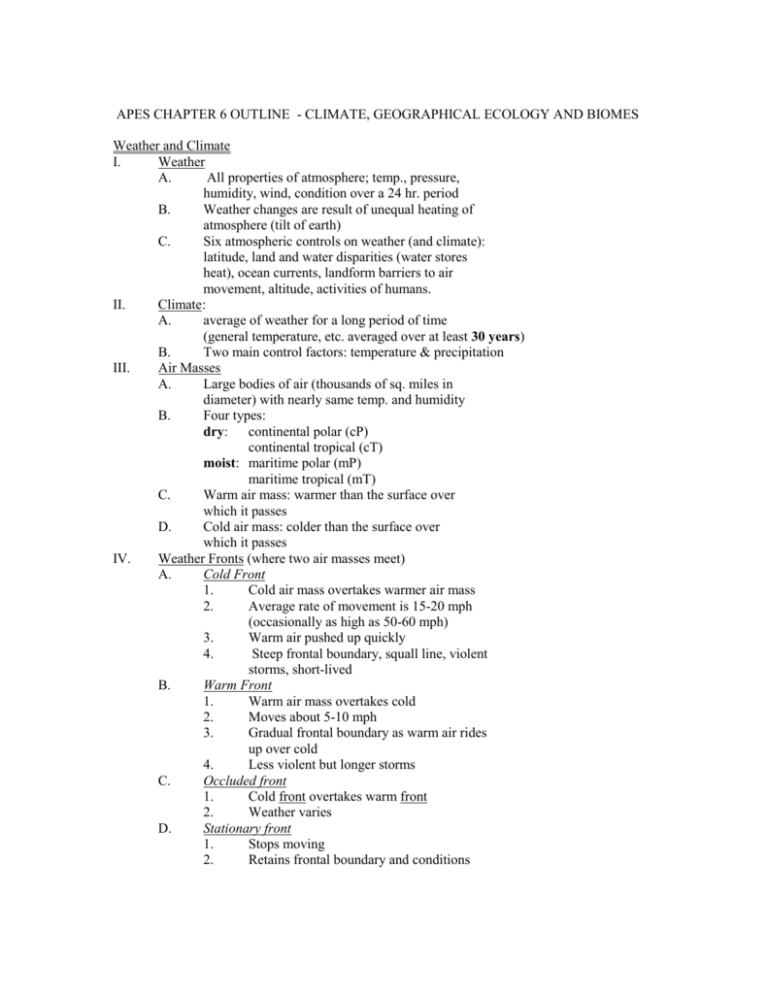
APES CHAPTER 6 OUTLINE - CLIMATE, GEOGRAPHICAL ECOLOGY AND BIOMES Weather and Climate I. Weather A. All properties of atmosphere; temp., pressure, humidity, wind, condition over a 24 hr. period B. Weather changes are result of unequal heating of atmosphere (tilt of earth) C. Six atmospheric controls on weather (and climate): latitude, land and water disparities (water stores heat), ocean currents, landform barriers to air movement, altitude, activities of humans. II. Climate: A. average of weather for a long period of time (general temperature, etc. averaged over at least 30 years) B. Two main control factors: temperature & precipitation III. Air Masses A. Large bodies of air (thousands of sq. miles in diameter) with nearly same temp. and humidity B. Four types: dry: continental polar (cP) continental tropical (cT) moist: maritime polar (mP) maritime tropical (mT) C. Warm air mass: warmer than the surface over which it passes D. Cold air mass: colder than the surface over which it passes IV. Weather Fronts (where two air masses meet) A. Cold Front 1. Cold air mass overtakes warmer air mass 2. Average rate of movement is 15-20 mph (occasionally as high as 50-60 mph) 3. Warm air pushed up quickly 4. Steep frontal boundary, squall line, violent storms, short-lived B. Warm Front 1. Warm air mass overtakes cold 2. Moves about 5-10 mph 3. Gradual frontal boundary as warm air rides up over cold 4. Less violent but longer storms C. Occluded front 1. Cold front overtakes warm front 2. Weather varies D. Stationary front 1. Stops moving 2. Retains frontal boundary and conditions E. V. Weather extremes 1. Tropical cyclones a. severe tropical storms, called hurricanes in Atlantic and typhoons in Pacific b. Form over warm tropical waters in late summer or early fall c. Powered by heat energy from the sea d. Major damage is from storm surge (90% of deaths from this) and winds 2. Tornadoes – short lived cyclonic winds than can reach in excess of 300 mph Global Air Circulation and Climate A. Two most important factors in climate are temperature and precipitation B. Air circulation result of 1. Unequal heating and cooling of earth result mainly from tilt of earth’s axis (causes seasons) a. Equator receives more direct sunlight than poles so more energy and thus warmer b. Part of earth tilted toward sun receives more direct sunlight and thus warmer We are actually closer to the sun in the winter than in the summer. 2. Rotation of earth on axis a. Creates Coriolis effect b. Wind deflected toward right in northern hemisphere and left in southern Convection cells of rising moist air and sinking cool, dry air VI. El-Nino Southern Ocillation – ENSO – (Major topic- study) OVERVIEW El-Nino- Effect Global Weather and Climatic Patterns a) Characterized by unusually warm ocean temp in Equatorial Pacific Ocean. b) Causes trade winds to relax in central and western Pacific. c) The trade winds reverse normal patternNormal-trade winds flow from a westerly direction El-nino-trade winds flow from a easterly direction Climate change: wetter conditions promote transmission of disease by: 1. Increasing the regions where mosquitoes breed-some mosquitoes are carriers of diseases such as malaria, dengue fever, or yellow fever. 2. Causing flooding, causing a problem because of sanitation (e.g., contamination of water sources with bacteria that may promote the spread of cholera, amoebic dysentery, giardia). Climate change: warmer water promotes transmission of disease because: 1. Warmer water allows for increased growth of phytoplankton and zooplankton 2. Bacterial growth increases in warm water 3. Increased temperatures may mean increased breeding of insects Climate change: higher air/land temperatures promote transmission of disease because: 1. Higher temperatures give insects (such as mosquitoes) a longer window of reproduction ties 2. Increased temperatures may mean increase breeding and feeding of insects 3. Higher wintertime temperatures may mean insect populations that carry disease are increased since not as many will be killed by freezes Climate change: slightly drier conditions promote transmission of disease by: 1. Causing streams to become stagnant, resulting in standing ponds of water that are conductive to increased mosquito populations. (One of the biggest outbreaks of dengue fever in Fiji occurred during the last major ENSO event when Fiji was unusually dry.) Climate change: drought promotes transmission of disease by causing: 1. Deterioration in fresh water supplies (shortage of potable water; concentration of pollutants in shallow ponds) increases the probability of diseases such as cholera and other diarrheal diseases in places such as Papua New Guinea Problems with climate change: 1. People most affected by the link between El Nino and disease are those where the weather/climate changes are most extreme and health care and sanitation are marginal (developing countries) Diagram of Normal and El-Nino Conditions ENSO may cause Warming water (Primarily ocean) Problems (e.g.) Habitat Destruction Increased algal blooms Coral Bleaching Disruption of migration No Upwelling of nutrient-rich waters Die-off of species that cannot tolerate the warmth Lowered water-solubility of CO2 gas Increased storms/shift of zones where storms form. Increase in greenhouse gases cause more frequent/stronger el nino. Depression of thermocline Suppression of upwelling Disruption of migration Destruction of habitat Flooding Mudslides Erosion Nutrient Leaching. Across Southern US (Flooding) Across Peru (Flooding) Drought/lack of water for living organisms Increased risk of fires Less plant growth Species unable to adapt Drought Effects (e.g.) Starvation/die-off of species. Changes in ocean currents Disruption of migration Disruptions of food webs Flooding Loss of habitat Contaminated water supplies Nutrient leaching from soils Health- Causes septic tanks, city sewer systems, and animal waste from agribusiness; mix with floodwaters – distributing coliform bacteria. Increased risk of fires Lack of water for living organisms West Pacific (Brush fires in Australia) Flooding Increased coastal erosion by waves Species die-offs Reduced potable water Poor/no plant growth Movement of warm ocean waters/increasing depth of warm surface water Increased rainfall Decreased Rainfall Increased land temperature Drought Increased storms (number, frequency, or strength) Loss of food for higher trophic levels. Disruption of food webs. Loss of biodiversity. Nutrient-rich waters not available for fish Loss of food Starvation/die-off of species. Habitat destruction Plants unable to grow/loss of food production Starvation/die-offs Habitat destruction Habitat destruction Starvation/die-offs Habitat destruction Decreased food Starvation/die-offs Habitat destruction. La-Nina- opposite of El-Nino a) Characterized by unusually cold ocean temp in the Equatorial Pacific b) Usually, (but not always) occurs after an El-Nino year Weather: 1. Warm winters in S.E. U.S. 2. Colder winters from great lakes to Pacific N.W. 3. Mixture of bad/good in N.E. and Middle Atlantic states VII Continental Drift Theory: - Approx. 225 MYA one super-continent existed. It was called Pangaea meaning “all lands”. 135 Million years ago Pangaea broke apart – the southern half was called Gondwanaland and the Northern portion was called Laurasia. 65 MYA the 7 major continents formed and moved into the locations we see on maps today. (Pg. 106) 1. Plate tectonics - the study of the movement of the Earth’s crust. There are 20 lithospheric plates. 7 major plates, (continents) and 13 minor plates. 2. Lithosphere – crust and upper portion of the mantle 3. Athenosphere – lower mantle. ( lithosphere floats on the athenosphere) 4. Convection currents – produced from the intense heat of the inner core, are the driving force behind seafloor spreading 5. Seafloor spreading- Hess, 1962, mapping ocean floor, searching for mineral deposits, mapped the largest underwater mountain chain on the planet. Called the Mid Atlantic ridge. Seafloor is thin layer of Basalt, magma pushes to the surface and moves the plates apart – divergent plate boundary. Plates come together – Convergent plate boundary –builds mountains. Subduction Zone – two plates come together and one plate subducts or goes under the other plate and its material is remelted into the magma – Pacific Ocean. California is made of several small pieces of plates that jammed together- Thus earthquakes – occur at all plate boundaries. Rate of movement at the MAR –2-3 cm per year. 6. In 1912 Alfred Wegener, proposed the theory of Continental Drift –( Continents move) – scientific community thought his theory was incorrect. Not until we understood convection currents and seafloor spreading did this get proven: Evidence : 1. plates fit together like a puzzle 2. fossil record 3. convection currents and seafloor spreading VIII BIOMES: CLIMATE & LIFE ON LAND Why are there different organisms in different places? a) differences in climate b) results from differences in average temp. & precip. Biome – terrestrial regions with characteristic types of natural, undisturbed ecological communities adapted to the climate of the region. For plants, precip. Is the limiting factor which determines if a region is going to be a desert, grassland, or forest. Average annual precip, temp, & soil type determine the type of biome.\ Biomes are not uniform – consists of a patchwork of different ecological communities, all with similiarities unique to that biome. Climate & biomes vary with latitude, ( distance from equator), and altitude, (elevation above sea level). From equator towards poles climates - colder Why do plant sizes, forms, & survival strategies differ? Main determining factors are : climate & soil type Types: a) Succulent ( fleshy) plants, such as the saquaro cactus – most surfaces on the plant have vertical orientation – limits amount of direct sun. no leaves, the ability to store food & water in the fleshy parts of the plant, open the pores, (stomata) only at night to take in CO2. b) Broadleaf evergreen plants – keep most of their broadleaves year round, large surface of area of leaves help in photosynthesis & radiate out heat during the day. c) Broadleaf deciduous plants – shed their leaves to survive cold & drought, become dormant during these periods , oak, maple d) Coniferous Evergreen plants – Canada, northern regions, keep some of their narrow pointed leaves (needles) all year, leaves have a waxy covering that slows down heat loss & water evaporation, contain cones which bear seeds Keystone species – Species that play roles affecting many other organisms in an ecosystem. Indicator species – Species that serve as early warnings that a community or an ecosystem is being degraded. Immigrant species or non-nativespecies – species that migrate into an area or are accidentally introduced by humans. Native species – species that usually live & thrive in a particular ecosystem IX. Desert Biome: Desert- an area where evaporation exceeds precipitation. Facts: a) covers 30% land- 30% N/S equator b) largest desert- located on interior of continent 3 types: Tropical desert high temp year round little rain driest place on earth, few plants Temperate desert daytime temp are high in summer and low in winter there is more precipitation then in tropical deserts Cold deserts winters are cold summers are warm or hot precipitation is low How do Desert Animals and Plants Survive wax coating on leaves prevents H2O loss deep tap roots- plants dormant during dry periods animal hide deep burrows thick outer skin- consumes H2O DRAW A TYPICAL DESERT FOOD WEB. X. Grassland, Tundra, and Chaparral Biomes A) What are the Major Types of Grasslands? Grasslands- regions with enough average annual precipitation to allow grass to prosper but with precipitation so erratic that drought and fire prevent large stands of trees from growing. 1.) Grasslands persist because of: a) seasonal drought b) grazing by large herbivores c) occasional fires 2.) Three types: a) tropical b) temperate c) polar d) B) What are Tropical Grasslands and Savannas? 1. Tropical grasslands are found in areas with: a) high temperatures b) low to moderate precipitation c) a prolonged dry season d) A type of tropical grassland, called a savanna usually has: 1) warm temperatures year round 2) two prolonged dry seasons 3) abundant rain the rest of the year largest savannas are in central and southern Africa, but they are also found in central South America, Australia, and Southern Asia. e) African tropical savannas contain enormous herds of: 1) Grazing animals – grass eating herbivores 2) Browsing animals - twig and leaf nibbling a) example: 1) giraffes eat leaves and shoots from the tops of trees 2) elephants eat leaves and branches further down 3) Thompson’s gazelles and wildebeests prefer short grass 4) Zebras graze on longer grass and stems 5) C) What are Temperate Grasslands? Temperate grasslands cover vast expanses of plains and gently rolling hills in the interiors of North and South America, Europe, and Asia. Characteristics: 1) winters are bitterly cold 2) summers are hot and dry 3) annual precipitation is fairly sparse and falls unevenly thought the year. a) Types of temperate grasslands: 1) Tall-grass prairies and short- grass prairies of the Midwestern and western United States and Canada. 2) South American pampas 3) African veldt 4) Steppes of central Europe and Asia D. Polar Grasslands Or Arctic tundra, occur just south of the arctic polar ice cap. Most of the year these treeless plains are: a) bitterly cold b) swept by frigid winds c) covered by ice & snow d) carpeted with a thick spongy mat of low growing plants. Primarily grasses, mosses, and low shrubs e) Plants grow close to the ground – some evergreens – waxy coating on leaves f) Permafrost – frozen layer of the soil – prevents water from seeping into ground g) Brief summer – soil remains waterlogged – bogs h) Caribou, reindeer, wolf, ground squirrels, snowy owl Survive the extreme cold by: a) Do not hibernate – summer to short to store fat b) Burrow underground c) Thick coats of fur or feathers d) Compact bodies to limit exposure E. Alpine Tundra Occurs above the limit of tree growth but below the permafrost line on high mountains. The vegetation is similar to the arctic tundra, but get more sunlight. No permafrost layer F. Chaparral Also known as a temperate shrubland. This biome occurs along coastal areas with what is called a Mediterranean climate – mild winters, moderately rainy, long, hot, dry summers. Pacific coast of North America, southern Texas, Chilie, Southwest africa a) dominated by dense growth of low growing evergreen shrubs b) leathery leaves – resist water loss, large underground root system c) prone to fires – brittle vegetation in summer d) some plants store food reserve in fire resistant roots e) have seeds that only sprout after a fire G. Human impact on Grasslands: f) Conversion of savanna and temperate grasslands to cropland g) Release of CO2 to atmosphere from burning and conversion to cropland h) Overgrazing of tropical and temperate grasslands by livestock i) Damage to fragile arctic tundra by oil production, air and water pollution, and vehicles. – long time to recover XI. Forest Biomes: Undisturbed area with moderate to high average precipitation. a) Three major Types: 1. Tropical 2. Temperate 3. Boreal (polar) A. Tropical Rain Forest: A type of broadleaf evergreen forest found near the equator. 1. has a warm annual mean temperature – varies little year-round 2. high humidity 3. heavy – daily rainfall 4. most diversity on Earth 5. rainforest area - covers about 2% of earth 6. habitats for 50 – 80 % of earth’s terrestrial species 7. Canopy layer – top – sunny –insects, birds 8. Diagram Pg. 137 - layers B. Tropical Deciduous Forest: Characteristics – 1. warm year round 2. get most of their rainfall during the wet (monsoon) season 3. lower canopy than tropical rain forest 4. deciduous trees – loose leaves to survive dry season 5. evergreen trees – retain leaves year-round C. Temperate deciduous Forest : 1. grow in areas with moderate average temperatures 2. long warm summers –cold –not severe winters 3. abundant precipitation spread evenly throughout the year 4. broadleaf deciduous plants – oak, hickory, maple 5. become dormant in winter –shed leaves 6. eastern U.S. D. Evergreen Coniferous Forests: 1. Aka boreal Forest or Taiga 2. Found south of arctic tundra in regions across north America, Europe, Asia 3. Subarctic climate – long winters, dry & cold, sunlight 6-8 hrs day, short summers 4. Cone bearing trees, needle shaped leaves, waxy covering, low plant diversity 5. Nutrient poor soil – acidic E. Temperate Rain Forest: 1. Along coastal areas with ample rainfall 2. Dense conifers –Douglas fir, redwoods 3. Canada and northern Calif. F. Human Impacts on the World’s Forest: 1. Clearing and degradation of tropical forests for agriculture, livestock, grazing, and timber harvesting. 2. Clearing of the Temperate deciduous forest in Europe, Asia, and North America for timber, agriculture and urban development 3. Clearing of the evergreen coniferous forest in North America, Finland, Sweden, Canada, Siberia, Russia 4. Conversion of forest to tree farms XII. Mountain Biomes: 1. Make up 20% of the earth’s land surface 2. Dramatic changes in altitude, climate, soil, and vegetation take place over a short distance 3. Above the snow line the mountain is always covered by snow 4. Ecological roles of mountains: a) Contain the majority of the worlds forests – habitats b) Help regulate the earth’s climate – reflect solar radiation –snow – top c) Hydrologic cycle Human Impacts on Mountain biomes: 1. 2. 3. 4. 5. 6. 7. Landless poor migrating uphill to survive Timber extraction Mineral resource extraction Increasing tourism Hydroelectric electric dams Air pollution from industry Increased exposure to UV radiation –O3 depletion
